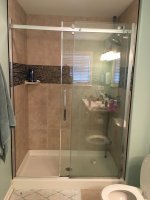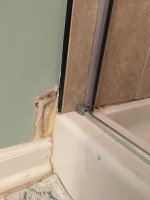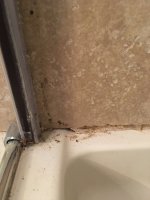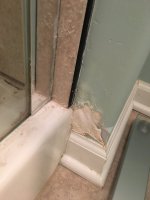Rachael243
New Member
We bought our house brand new in 2013. The shower in our master bath has tiled walls with a plastic shower pan. When we moved in the shower didn't have a door so my husband installed a frameless glass shower door himself. He silicones all the screw holes as stated in the installation instructions and caulked around the joints.
Over the next few months we notice the drywall that meets the shower wall/shower pan started to look like it was getting wet with every use of the shower. I thought maybe it was seeping through the grout so I sealed the tile myself to make sure that wasn't the problem. This seemed to help short-term, but after a month or two the drywall was getting wet again. It's gotten to the point where I repaired the drywall with spackel once and repainted it and it's desinigrated again. It looks awful.
The caulk that was surrounding the joint where the tile and shower pan meet started to look dark and very mildewy so I actually just ripped it all out today. When I did I noticed the grout behind in was very wet. What would cause this? How do I fix it? I've added a few pictures so you can get an idea of what I'm talking about
Over the next few months we notice the drywall that meets the shower wall/shower pan started to look like it was getting wet with every use of the shower. I thought maybe it was seeping through the grout so I sealed the tile myself to make sure that wasn't the problem. This seemed to help short-term, but after a month or two the drywall was getting wet again. It's gotten to the point where I repaired the drywall with spackel once and repainted it and it's desinigrated again. It looks awful.
The caulk that was surrounding the joint where the tile and shower pan meet started to look dark and very mildewy so I actually just ripped it all out today. When I did I noticed the grout behind in was very wet. What would cause this? How do I fix it? I've added a few pictures so you can get an idea of what I'm talking about




